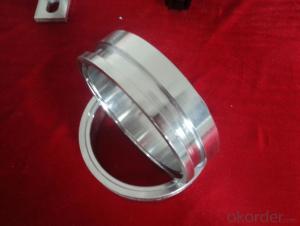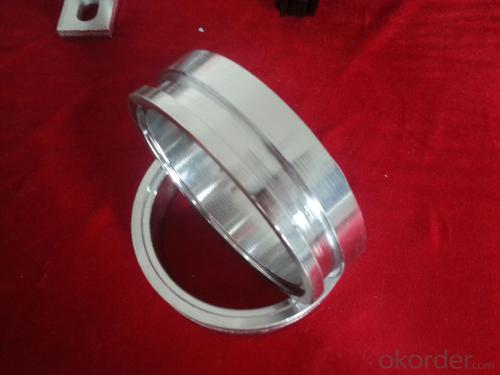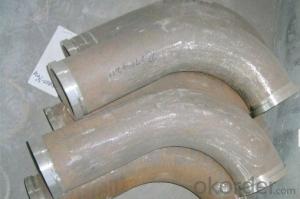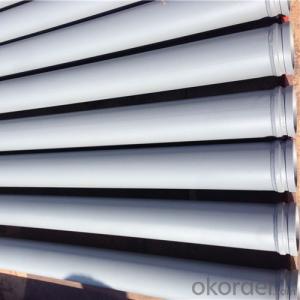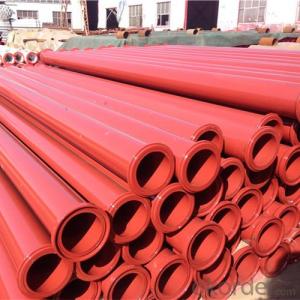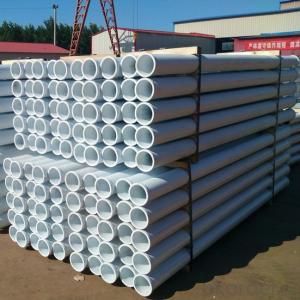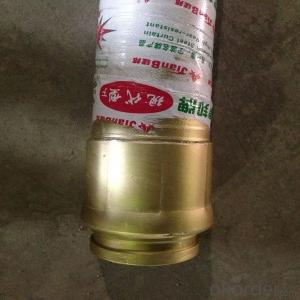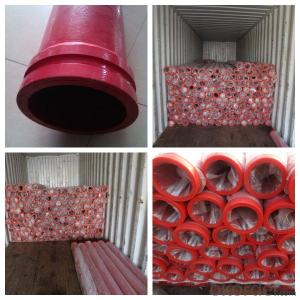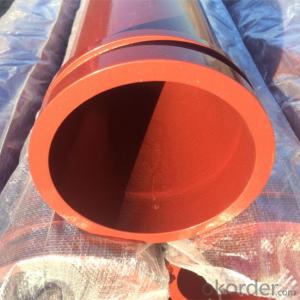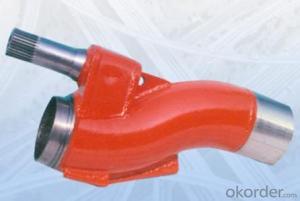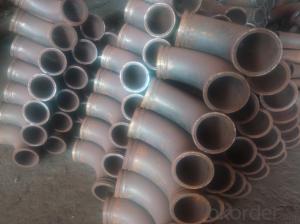Concrete Pump Flange SK
- Loading Port:
- China main port
- Payment Terms:
- TT OR LC
- Min Order Qty:
- 100 PCS
- Supply Capability:
- 10000 PCS/month
OKorder Service Pledge
OKorder Financial Service
You Might Also Like
Product Description:
A flance is a device used to connect two delivery pieps together at their ends for the purpose of transmitting, and prevent the concrete from leaking.
Main Product Features:
1. Use high quality steel.
2.convenient to use, easy operation,and high safety.
3.wear-resising,longer service life.
4.used in concrete pump truck,concrete pump and pipeline connection seal in construction
work equipment.
Product Specifications:
1.Forged
2.2--8 inch
3.Galvanizing/Baking varnish
4.More durable,light,beautiful
Production steps:
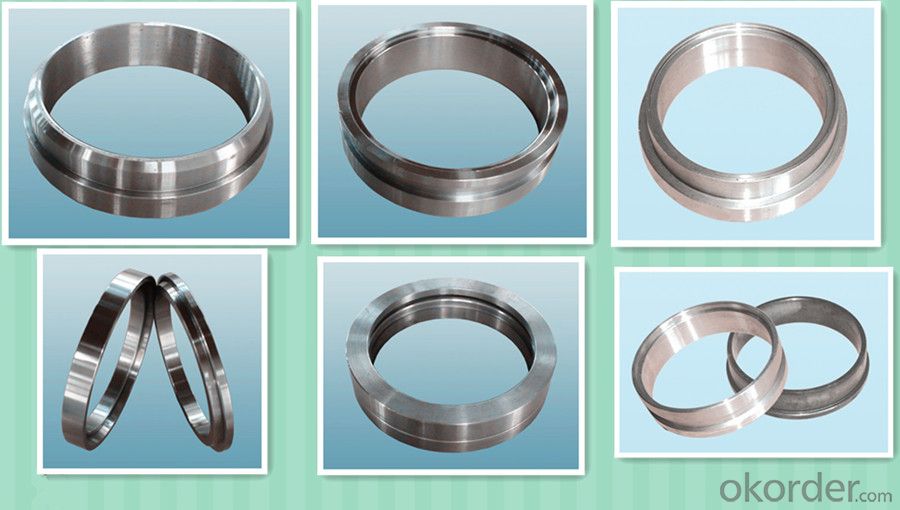
FAQ
1.How do you regarding your product quality?
As our principle is more safety to save more. In China, there are lots of manufactures of this line, but we are the first one that use the forging technic in producing, firmly meet the PM standard.
2.Can I get some samples?
Of course you can. Small sample for free, but you pay the express. For some products are not small, like concrete pump pipe, it’s very difficult to deliver one pipe of 3000mm. If it’s possible, we’d like that you can come here to visit our factory. Welcome!
3. I want to make our logo on the products, is that ok?
Yes, it’s totally ok. OME is available from us.What you should do is send your logo, brand name, or picture to us. And let other things leave on us.
- Q: Are there any maintenance tips to extend the lifespan of concrete pump spare parts?
- Yes, there are several maintenance tips that can help extend the lifespan of concrete pump spare parts. 1. Regular Cleaning: It is important to regularly clean the spare parts to remove any dirt, debris, or concrete buildup. This can be done using a brush, water, and mild detergent. Cleaning helps prevent corrosion and ensures smooth operation. 2. Lubrication: Proper lubrication of moving parts is crucial to reduce friction and wear. It is important to follow the manufacturer's recommendations for lubrication intervals and use high-quality lubricants. Regularly inspect the lubrication points and replace any worn-out or damaged lubrication components. 3. Inspections and Maintenance: Regular inspections of all spare parts are necessary to identify any signs of wear, damage, or misalignment. Any issues should be repaired or replaced promptly. Additionally, following the maintenance schedule provided by the manufacturer is essential to address any potential problems before they escalate. 4. Proper Storage: When not in use, spare parts should be stored in a clean and dry environment to prevent rust and corrosion. They should be protected from extreme temperatures, moisture, and direct sunlight. Additionally, spare parts should be stored in a way that prevents any damage or deformation. 5. Correct Usage: It is crucial to operate the concrete pump in accordance with the manufacturer's guidelines. Overloading, excessive pressure, or improper operation can lead to premature wear and damage to the spare parts. Proper training should be provided to the operators to ensure they understand the correct usage techniques. 6. Regular Maintenance of the Concrete Pump: The overall condition of the concrete pump can have an impact on the lifespan of the spare parts. Regular maintenance of the pump, including cleaning, lubrication, and inspections, can help identify and address any potential issues that may affect the spare parts. By following these maintenance tips, the lifespan of concrete pump spare parts can be extended, reducing the need for frequent replacements and saving costs in the long run.
- Q: How often should hopper agitator shaft seals be replaced in a concrete pump?
- The frequency at which hopper agitator shaft seals should be replaced in a concrete pump depends on several factors such as the type of pump, the amount of usage, the operating conditions, and the maintenance practices followed. Generally, hopper agitator shaft seals should be inspected regularly for signs of wear, damage, or leakage. If any issues are detected, they should be addressed promptly to prevent further damage. However, as a rough guideline, these seals may need to be replaced every 6 to 12 months or after approximately 500 to 1,000 operating hours. It is important to note that this is just an estimate, and the actual replacement frequency may vary. Factors such as the quality of the seals, the intensity of usage, and the conditions in which the pump operates can significantly influence the lifespan of the seals. Additionally, regular maintenance and proper lubrication can help extend the longevity of the seals. To ensure optimal performance and prevent potential issues, it is advisable to consult the manufacturer's recommendations and guidelines specific to the concrete pump model being used. Following their guidelines and regularly inspecting the seals will help determine the appropriate replacement interval for the hopper agitator shaft seals and ensure the pump operates efficiently.
- Q: How often should concrete pump accumulators be inspected and replaced?
- Concrete pump accumulators should be inspected on a regular basis to ensure their proper functioning and to prevent any potential issues. The frequency of inspections will depend on various factors such as the manufacturer's recommendations, the intensity of use, and the specific conditions in which the concrete pump is operating. As a general guideline, it is recommended to inspect concrete pump accumulators at least once every six months or after every 500 hours of operation, whichever comes first. However, if the pump is used more frequently or operates under harsh conditions, more frequent inspections may be necessary. During the inspection, the accumulators should be checked for any visible signs of wear or damage, such as leaks, cracks, or corrosion. Additionally, the pressure levels and performance of the accumulators should be tested to ensure they meet the required standards. When it comes to replacement, it is best to follow the manufacturer's recommendations. Typically, accumulators have a lifespan of around 3 to 5 years, but this can vary depending on factors such as maintenance, usage, and environmental conditions. If any significant issues are identified during the inspection or if the accumulators have reached their recommended lifespan, it is advisable to replace them promptly to avoid potential failures and ensure the safety and efficiency of the concrete pump.
- Q: Can I get spare parts for concrete pumps with different types of valve systems, such as S-valve or gate valve?
- Indeed, procuring spare parts for concrete pumps equipped with various valve systems, such as S-valve or gate valve, is entirely feasible. Manufacturers and suppliers of concrete pumps generally offer an extensive selection of spare parts, which encompass valves. These spare parts can be procured either directly from the manufacturer or via authorized distributors. To ensure compatibility, it is vital to furnish precise information regarding the concrete pump model, valve type, and any other pertinent details when placing an order for spare parts. Moreover, there exist specialized firms that exclusively concentrate on providing spare parts for concrete pumps, irrespective of the valve system employed. These entities often possess a comprehensive inventory of spare parts and can offer assistance in identifying and sourcing the necessary components for your specific concrete pump.
- Q: Can I get spare parts for both concrete pumps with and without lubrication systems?
- Yes, spare parts are available for both concrete pumps with and without lubrication systems.
- Q: What is the role of a concrete pump hopper grate spring?
- The role of a concrete pump hopper grate spring is to provide tension and support to the hopper grate, ensuring that it remains securely in place while allowing for smooth and consistent flow of concrete through the pump.
- Q: How can one determine the correct voltage and current rating for electrical components in concrete pump spare parts?
- To determine the correct voltage and current rating for electrical components in concrete pump spare parts, several factors need to be considered. Firstly, it is essential to consult the manufacturer's specifications and documentation for the concrete pump and its spare parts. These documents usually provide detailed information about the voltage and current requirements for each electrical component. Paying close attention to these guidelines ensures that the components are operated within their designed parameters. Secondly, it is crucial to understand the electrical system and its requirements. This involves analyzing the power supply available at the site where the concrete pump will be used. Factors such as the voltage level (e.g., 110V, 220V, 440V) and frequency (e.g., 50Hz, 60Hz) of the electrical supply need to be taken into account. Additionally, the maximum current capacity of the electrical system must be considered to prevent overload situations. Furthermore, it is advisable to assess the specific application and operating conditions of the concrete pump. Different components may have varying voltage and current requirements depending on their function and the environment in which they are used. For instance, components installed in outdoor areas may require higher voltage ratings to withstand harsh weather conditions. Lastly, seeking professional assistance from qualified electricians or engineers is highly recommended. They possess the expertise and knowledge to accurately determine the voltage and current ratings for electrical components in concrete pump spare parts. Their experience allows them to consider various factors such as safety regulations, compatibility with the existing electrical system, and any specific requirements of the concrete pump manufacturer. By taking into account the manufacturer's specifications, understanding the electrical system, considering the application and operating conditions, and seeking professional advice, one can effectively determine the correct voltage and current rating for electrical components in concrete pump spare parts.
- Q: What is the purpose of a concrete pump control panel?
- Operators use a concrete pump control panel to centrally control different functions and parameters of the concrete pump. By using this panel, operators can initiate and halt the pump, manage its speed and direction, and monitor and regulate the flow and pressure of the concrete being pumped. Safety measures like emergency stop buttons and alarms are also incorporated in the control panel to safeguard both the operators and the equipment. Additionally, the control panel may have diagnostic capabilities that present real-time data and alerts for maintenance and troubleshooting purposes. In summary, the aim of a concrete pump control panel is to improve efficiency, precision, and safety in the concrete pumping process.
- Q: What are the advantages of using genuine spare parts for my concrete pump?
- There are numerous benefits to utilizing authentic spare parts for your concrete pump. Firstly, these genuine components are specifically designed and produced by the original equipment manufacturer (OEM) for your concrete pump. This guarantees a perfect fit and optimal functioning with your particular model. By using genuine parts, you can avoid compatibility issues or malfunctions that may arise from using aftermarket or counterfeit parts. Furthermore, authentic spare parts are crafted from high-quality materials and undergo rigorous testing to meet stringent quality standards. This ensures their durability, reliability, and performance, resulting in a longer service life and reduced downtime for your concrete pump. Genuine parts are engineered to withstand the demanding conditions and heavy loads commonly encountered by concrete pumps. Moreover, the use of authentic spare parts helps preserve the warranty and integrity of your concrete pump. Many manufacturers offer warranties that cover the utilization of genuine parts. By utilizing genuine parts, you can take advantage of the warranty benefits and avoid any potential problems that may arise from using non-genuine parts, which could invalidate the warranty. In addition, authentic spare parts often come with technical support and expertise from the manufacturer. OEMs possess extensive knowledge and experience with their equipment, and their technical support team can provide guidance, advice, and troubleshooting assistance in the event of any issues. This can be highly advantageous in minimizing downtime and maximizing the efficiency of your concrete pump. Lastly, the use of authentic spare parts ensures the safety of your equipment and operators. Genuine parts are manufactured to meet strict safety regulations and standards, reducing the risk of accidents or failures that can result from using substandard or counterfeit parts. The safety and well-being of your team should always be a top priority, and the use of genuine parts helps guarantee their protection. In conclusion, the utilization of authentic spare parts for your concrete pump offers a range of advantages, including compatibility, quality, durability, warranty coverage, technical support, and safety. Investing in genuine parts not only enhances the performance and longevity of your equipment but also provides peace of mind for both you and your team.
- Q: What are the different types of concrete pump hopper screens?
- The different types of concrete pump hopper screens include wire mesh screens, perforated plate screens, and synthetic fiber screens.
Send your message to us
Concrete Pump Flange SK
- Loading Port:
- China main port
- Payment Terms:
- TT OR LC
- Min Order Qty:
- 100 PCS
- Supply Capability:
- 10000 PCS/month
OKorder Service Pledge
OKorder Financial Service
Similar products
Hot products
Hot Searches
Related keywords
